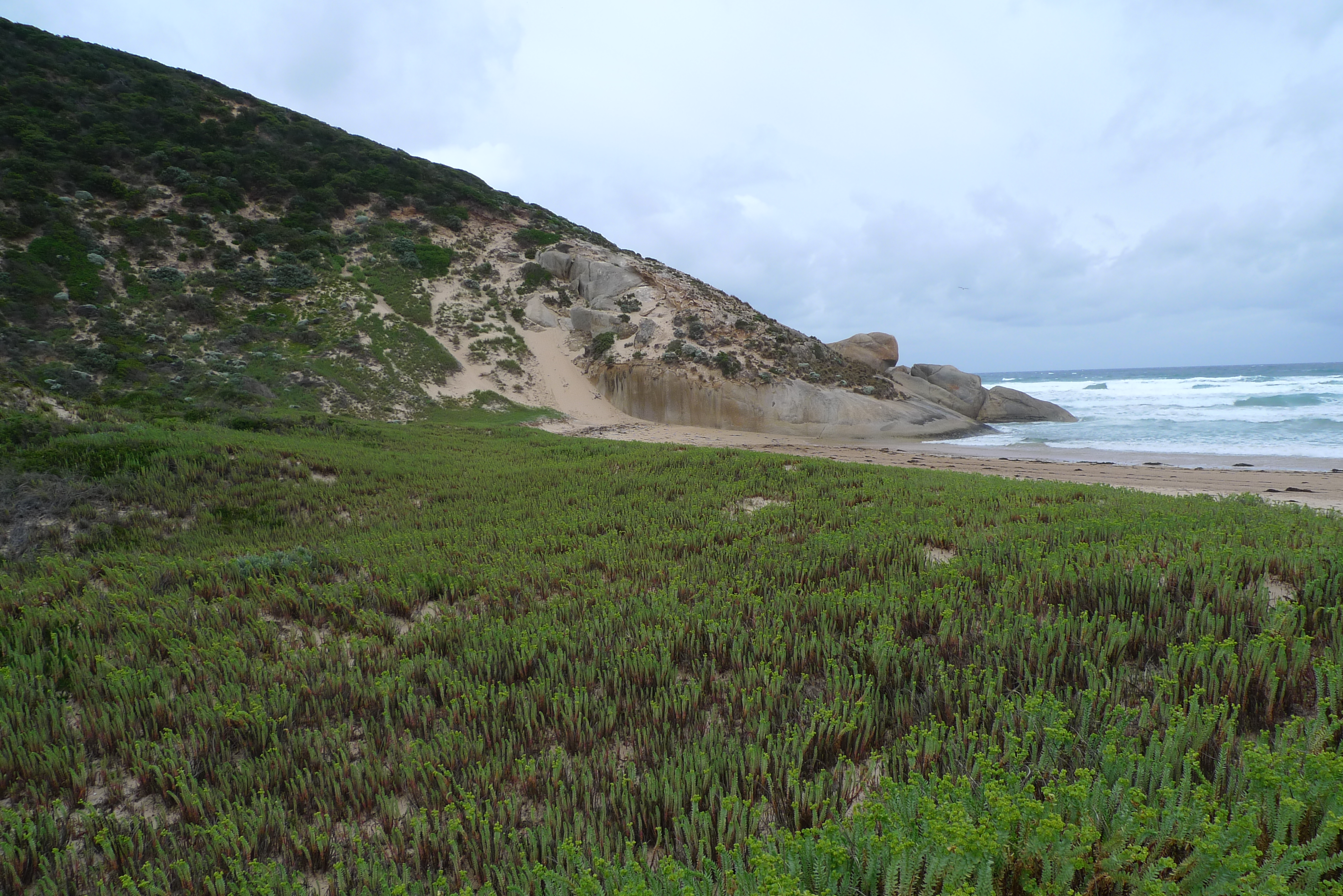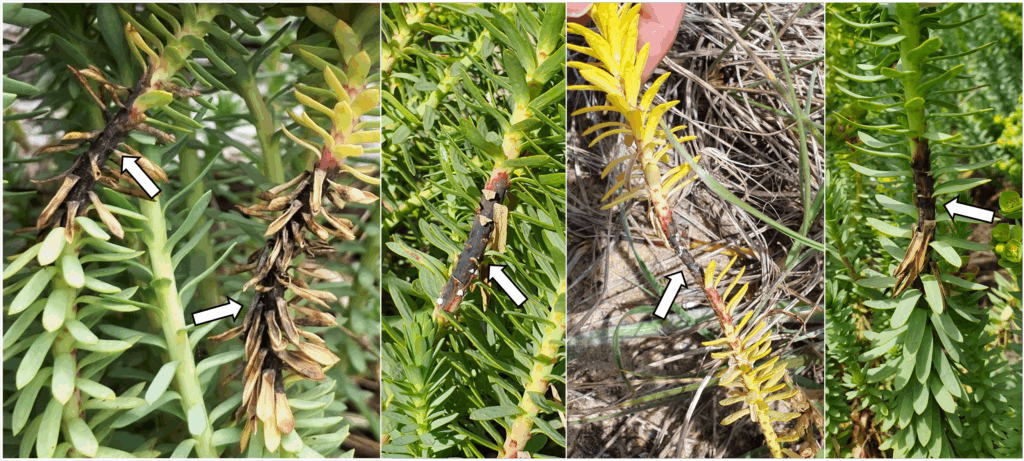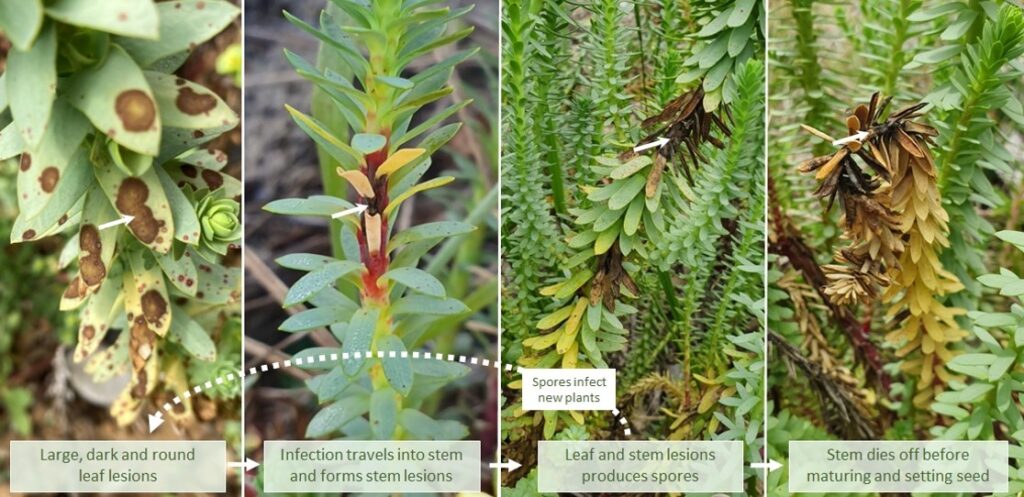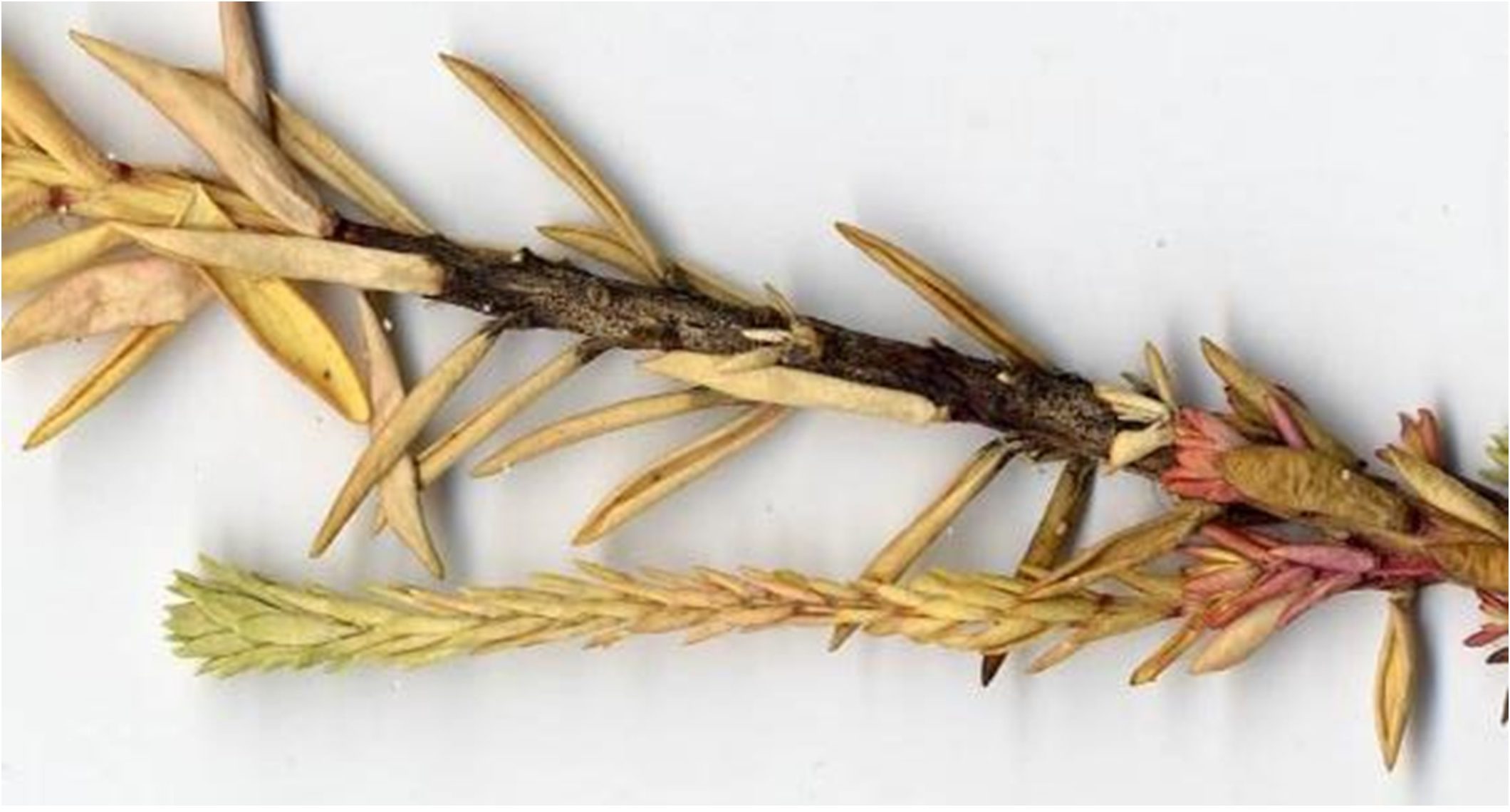Background
What is the weed problem?
Sea spurge is a significant environmental weed of coastal dune ecosystems in southern Australia. Re-invasion from ocean-dispersed seed is a constant threat to achieving long-term control. Along the NSW South Coast, sea spurge keeps re-invading sand dunes and is progressively moving northward. Infestations of sea spurge can negatively affect threatened flora and fauna species and Aboriginal cultural heritage sites, alter the geomorphic processes on the coast, transform native vegetation communities and reduce public amenity in coastal recreation areas. Sea spurge can also cause skin and eye irritations in those who inadvertently touch its milky latex sap. Each plant can produce up to 5000 seeds that can survive for several years on ocean currents – the primary means of dissemination from beach to beach.

How is the weed currently managed?
Control of sea spurge infestations with manual and chemical control techniques is difficult because of the close proximity to estuaries, the marine environment and native vegetation, its persistent seed banks, and constant re-invasion from beaches within and outside of NSW. Government agencies and local community groups devote large amount of time controlling it, but ongoing efforts are required because of the established seed bank and the relentless re-invasion that occurs.
Hand pulling of sea spurge is popular with community groups, as it requires no special training, costs little, and avoids exposing community members to chemical herbicides. It can be quite effective for small populations less than a few thousand individuals. The incomplete removal of the plants’ roots however, can lead to their re-establishment. Even when plants are completely removed, recruitment of seedlings from the seed bank can occur for up to ten years. The application of herbicides is popular with land management agencies (parks, local councils or NRM organisations). While often effective in reducing large populations of sea spurge, herbicides can cause off-target damage to sensitive native coastal vegetation and aquatic and marine ecosystems.
What can biocontrol offer to the weed’s management?
The hardiness, mobility and longevity of sea spurge’s seeds in combination with the remote locations of many infestations, make management of sea spurge in southern Australia difficult using currently available control methods. Biological control would provide a sustainable, landscape scale approach for sea spurge management with no chance of off-target damage. A successful biocontrol program across the range of sea spurge in Australia would reduce the density of populations and seed production, thus reducing spread via ocean currents and infestation of new beaches. A substantial improvement of biodiversity outcomes would be expected from a progressive reduction of the number of beaches invaded by sea spurge as a result of biocontrol and the commensurate recovery of dune habitats for native flora and fauna.
Information on the fungal biocontrol agent, Venturia paralias
The biocontrol agent is a fungus, called Venturia paralias, that causes disease in sea spurge. It was originally isolated from diseased sea spurge plants in France. Through extensive host-specificity studies undertaken by the CSIRO, the fungus was shown to be highly specific to sea spurge and poses no danger to Australian flora. It was approved in 2020 for release into the Australian environment for the biocontrol of sea spurge.
The fungus infects leaves of sea spurge, causing brown leaf lesions. From infected leaves it moves to the stem, where it causes dark brown to black lesions that progressively extend along the stem. Under humid conditions, the fungus produces spores on lesions that spread to other nearby sea spurge plants by wind and rain to begin new infections. The fungus impedes the photosynthetic capacity of sea spurge leaves and disrupts the translocation of water and photosynthates in the stem. If the fungus establishes widely and causes severe disease symptoms, it will likely decrease the reproductive output of sea spurge plants and become an important addition to existing sea spurge management practices in Australia.
Sea spurge biocontrol FAQs
Who is eligible to participate in the sea spurge biocontrol program?
All interested stakeholders are eligible to participate in the sea spurge biocontrol program. Participation is collaborative: CSIRO will provide the biocontrol fungus Venturia paralias, along with training, release kits, and monitoring guidelines. Participants contribute by releasing the fungus at approved sites and managing their own site access and permissions.
The program is especially suited to community groups and government agencies already working to control sea spurge on the ground. A key focus is partnering with Indigenous organisations to support releases that align with cultural values, interests, and approaches to coastal weed management. CSIRO welcomes conversations about how this engagement can be meaningfully supported.
Note that the fungus has been approved for release into the Australian environment, and no further biosecurity risk assessments are required for site-level releases. CSIRO has secured the necessary permissions for the fungus to enter all states and territories across Australia. However, each participant may need to navigate additional permissions related to site access and safety while conducting on-ground activities. CSIRO does not hold liability for participant activity once the fungus has been received.
What support is provided to participants in the sea spurge biocontrol program?
CSIRO is Australia’s national science agency and leads the national weed biocontrol pipeline program. While CSIRO does not provide on-ground weed control services, it undertakes strategic research to develop and implement biocontrol programs that move approved agents from the laboratory into the Australian environment to reduce weed threats over time.
All CSIRO biocontrol programs are collaborative. CSIRO does not fund weed control directly. Instead, mass-release programs are delivered in partnership with stakeholders who contribute their own resources. This may include landholders releasing biocontrol agents on their properties or community groups undertaking releases as part of their volunteer activities.
To support these efforts, CSIRO provides:
- Biocontrol agent release kits free of charge,
- Training materials and online resources,
- Access to dedicated staff who can help design release programs tailored to local needs,
- Workshops and field demonstrations,
- Presentations of results at conferences and community forums.
We welcome expressions of interest and are happy to discuss how we can partner with you to deliver the project in your region.
How is the biocontrol fungus provided to participants, and are there limits on availability?
CSIRO maintains and develops live cultures of the biocontrol agent Venturia paralias in its pathogen laboratories in Canberra and Floreat, WA. These cultures are carefully managed to ensure they remain healthy and uncontaminated for release into the Australian environment. We are currently scaling up our mass-rearing pipeline to support national distribution of the fungus over the next two years until June 2027. However, this process takes time. In many cases, we are unable to provide the fungus immediately upon request.
Instead, we register interest and work collaboratively with each participant to determine the quantity of material needed based on the number of release sites and the density of sea spurge at each location. We also coordinate the timing of releases to align with both the availability of the fungus and the local climate conditions that support successful establishment.
Demand for participation is expected to be high. We will endeavour to meet this demand, as we did in our previous project, which saw releases at approximately 230 locations across Tasmania and Victoria between 2021 and 2024 (see here: https://research.csiro.au/sea-spurge/previous-research-2017-2024/). We anticipate a lead time of at least 3–6 months from registration to delivery. This allows us to culture viable fungus and co-design a release strategy tailored to each participant’s needs.
How is the fungus released?
The successful establishment of the sea spurge fungus relies on the release of viable spores using CSIRO’s approved methods. Participants in the program will receive a biocontrol agent release kit containing dried spores, along with detailed instructions and training materials to guide the release process.
The fungus is applied directly to sea spurge plants in the field, typically by mixing the spores with water and spraying them onto the foliage under suitable environmental conditions. These methods have been developed and tested by CSIRO to maximise the chances of infection and establishment.
It is important to note that simply translocating infected stems from one beach to another is not effective. CSIRO has tested this approach and found that it does not result in successful transfer of the fungus. For the biocontrol agent to establish and spread, spores must be released using the correct techniques and under the right conditions, particularly when humidity is high, such as during overnight coastal dew events.
By following the approved release protocols, community participants can help ensure the fungus establishes effectively and contributes to long-term suppression of sea spurge.

A vial containing Venturia paralias
What quantity of the biocontrol agent will I receive for release into the environment?
Registered participants will receive 2 or more “biocontrol agent release kits” by post. Each kit contains a plastic vial of dried spores of the fungus Venturia paralias. This vial can be used to make a release at one site on approx. 3-5 sea spurge plants. Each release kit released should be separated by at least 200 m to enable broadscale distribution of the fungus in the local landscape. Once these plants are infected, the fungus will develop pustules that produce spores, which can then naturally spread to nearby plants via wind or water.
CSIRO staff will work with you to determine the number of release kits provided, based on your capacity to release the fungus in your local area. To improve the chances of successful establishment at each beach, we recommend releasing the fungus at two separate locations using two vials, ideally spaced apart.
There is no limit to the number of release kits that can be requested. However, releases will be staggered over the two years of the project, which runs until June 2027. We welcome collaboration with stakeholders interested in making multiple releases across broad regions, integrated into existing sea spurge control programs. This approach will maximise the impact of the fungus at the landscape scale.
Does the fungus establish reliably, and what is its natural spread potential?
Field trials and community-led releases of Venturia paralias between 2021 and 2024 have shown that the fungus can establish well in the field. Across 231 release sites in Victoria and Tasmania, successful infection was confirmed at 61% of monitored locations. This means that while establishment is promising, it is not guaranteed and community groups are encouraged to release the fungus multiple times to maximise the chances of success.
Monitoring data also show that the fungus can spread within a beach over time. In Victoria, it dispersed up to 1,500 metres from initial release points, and in Tasmania, up to 200 metres. However, there is currently no evidence that the fungus can spread between beaches over the same time period. Long-distance dispersal appears limited and is likely to take many years.
This highlights the importance of human-assisted distribution. By working with community groups to release the fungus across multiple sites and regions, we can accelerate its spread and maximise its impact at the landscape scale.
You can read more about the results from the previous research here: https://research.csiro.au/sea-spurge/previous-research-2017-2024/

Stem symptoms of the biocontrol agent on sea spurge
How does the fungus affect sea spurge health and populations?
The biocontrol fungus Venturia paralias significantly reduces the health and reproductive capacity of sea spurge plants. In previous research between 2021 and 2024, it was shown across monitored sites in Victoria and Tasmania that infected plants developed visible disease symptoms (particularly stem and leaf lesions) within 6–7 months of release. These symptoms became more widespread over time, with infection detected in up to 93% of plots at some sites.
One of the most damaging effects of the fungus is the formation of stem lesions that girdle the plant’s stems. These lesions disrupt the vascular tissue, leading to stem death and preventing seed set. This directly reduces the plant’s ability to reproduce and spread.
However, the fungus does not typically kill the entire plant outright. Sea spurge can reshoot new stems from its rootstock, meaning that complete eradication is not possible from a single infection. Instead, what we expect to see over many years is a gradual decline in sea spurge populations. This occurs through a combination of reduced seed production and progressive thinning of the plant as new shoots become infected, and the fungus becomes sustained in the local environment.
You can read more about the results from the previous research here: https://research.csiro.au/sea-spurge/previous-research-2017-2024/

Lifecycle of Venturia paralias
What happens if I cannot detect the fungus after release? Has it failed?
Not necessarily. While Venturia paralias has shown strong establishment in many coastal sites, its success is not guaranteed. The fungus requires suitable environmental conditions (particularly humidity) to infect sea spurge effectively. Coastal areas typically offer high ambient humidity overnight, which has supported successful establishment in Victoria and Tasmania. However, local conditions may vary, and some releases may not result in immediate infection.
If the fungus is not detected after release, it does not mean the effort has failed. Limited establishment can often be overcome by releasing the fungus multiple times in the same area and over time. Repeated releases increase the likelihood of infection and help build up fungal presence in the local environment.
It is important to note that biocontrol is not a quick fix. Evidence from Victoria and Tasmania shows that visible impacts on sea spurge, such as reduced plant health and cover, may take at least three years to emerge. Biocontrol represents a long-term, sustainable approach to weed management, with benefits accumulating gradually over years to decades.
This highlights the value of community involvement in the release program. Human-assisted dispersal of the fungus is essential to accelerate its spread across the landscape, especially since long-distance natural dispersal between beaches is likely to be limited and slow.
Can use of the biocontrol agent replace herbicide application or other control methods?
Biocontrol using the fungus Venturia paralias offers a sustainable, landscape-scale approach to managing sea spurge, with no risk of off-target damage to native vegetation or crops. However, the fungus is not expected to kill sea spurge plants outright. While it can cause stem death and reduce seed production, plants may reshoot from their rootstock, meaning that infestations may persist.
As such, biocontrol will complement but not replace other control methods such as manual removal or herbicide application. Over time, widespread establishment of the fungus is expected to reduce the vigour and reproductive capacity of sea spurge populations, which may in turn reduce the frequency and intensity of other control efforts required. Biocontrol is not a “silver bullet”.
Integration with other control methods can take many forms and should be underpinned by planning in collaboration with CSIRO. For example, the fungus can be released in inaccessible locations where chemical, mechanical, or manual control is not feasible over the long term, allowing the fungus to establish and suppress sea spurge sustainably. The fungus can also be released in ecologically sensitive areas where disturbance to dune ecosystems or herbicide use is restricted.
Other forms of integration may be staggered over time. For instance, a sea spurge population may be manually removed in the first instance, while nearby releases of the fungus can help suppress any new sea spurge plants that regenerate after primary control. This layered approach may enhance long-term management and maximise the impact of the fungus across the landscape.
Previous research (pre-2017)
Due to its importance as an environmental weed, sea spurge was nominated and endorsed by the national Invasive Plants and Animals Committee (IPAC; now known as the Environment and Invasives Committee) as a target for biological control in Australia in August 2010.
In previous projects supported by the Tasmanian government and the Rural Industries Research and Development Corporation (RIRDC; now known as Agrifutures Australia), two damaging fungi with potential for biocontrol – the foliar blight fungus Venturia paralias (previously referred to as Passalora euphorbiae) and the rust fungus Melampsora euphorbiae – were discovered on sea spurge during field surveys in France and Spain. Initial tests, performed at the CSIRO European Laboratory in France, indicated that the two pathogens may be promising candidate biocontrol agents for sea spurge in Australia (Scott et al. 2010, 2012). Out of 15 non-target species tested with the rust fungus, only Euphorbia marginata and E. dendroides developed disease symptoms, albeit not as severe as those on sea spurge. Preliminary testing with the fungus showed that it is possibly highly specific. It was tested on eight Euphorbia species, but none were native to Australia. It was also tested on two species in the sub-family Acalyphoideae and one species in a related family to Euphorbiaceae. In all tests, disease symptoms only developed on sea spurge. The damage caused by the fungus on sea spurge in the field is impressive in the native range (M. Jourdan pers. comm.).

Baseline data on sea spurge growth, phenology and reproductive output, and impact on native vegetation were gathered in 2011-12 at sites in WA and Victoria (Scott et al. 2012). A recent Honours thesis at Wollongong University (Kelly 2015), indicated that sea spurge is or has been present at 309 of the 481 beaches (64.2%) assessed in NSW based on information gathered from land managers, management documents and field surveys.
Kelly LJM (2015) Patterns of sea spurge (Euphorbia paralias) invasion in New South Wales, Australia. Honours Thesis, The University of Wollongong.
Scott JK, Jourdan M, Morin L, Thomann T, Yeoh P (2010) Exploration for potential biological control agents of Euphorbia paralias, a major environmental weed of coastal ecosystems in Australia. In: Proceedings of the 17th Australasian Weeds Conference, (ed. Zydenbos SM), pp. 223-226. New Zealand Plant Protection Society Inc., Christchurch. http://caws.nzpps.org/awc/2010/awc201012231.pdf
Scott JK, Jourdan M, Morin L, Webber BL, Yeoh PB, Ebeling SK, Cousens R (2012) Sea spurge, Euphorbia paralias, ecological assessment and testing of potential biological control agents. In: Proceedings of the 18th Australasian Weeds Conference, (ed. Eldershaw V), pp. 223-226. Weed Society of Victoria Inc., Melbourne. http://caws.nzpps.org/awc/2012/awc201213751.pdf
